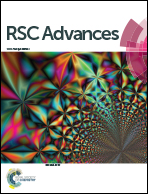Evidence of microscopic correlation between biofilm kinetics and divalent cations for enhanced wastewater treatment efficiency†
Abstract
Biofilm-bacterial communities have been exploited in various biological wastewater treatment processes. The present work is aimed at exploring the possible factors for tailoring biofilm mechanics by introducing divalent cations (Ca2+) in the constructed wetland soil. The in vitro investigation of soil samples collected at various retention times revealed that the addition of Ca2+ facilitates the formation of well organized patterns of biofilm compared to calcium depleted conditions. Afterwards, Ca2+ ions were intentionally introduced into the soil of lab-scale constructed wetland to examine its superior treatment efficiency towards the removal of various chemical and microbiological contaminants. The current work therefore may form a basis to implement theoretical predictions experimentally in a real time existing wastewater treatment technology. Hence, the same approach can effectively be adopted in pilot scale wetland systems as well as other biofilm mediated wastewater treatment technologies.


 Please wait while we load your content...
Please wait while we load your content...